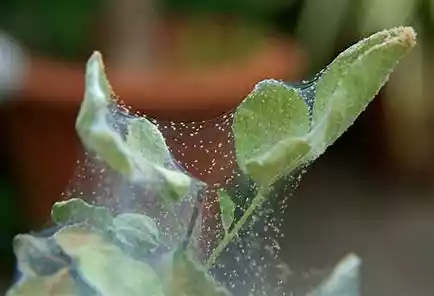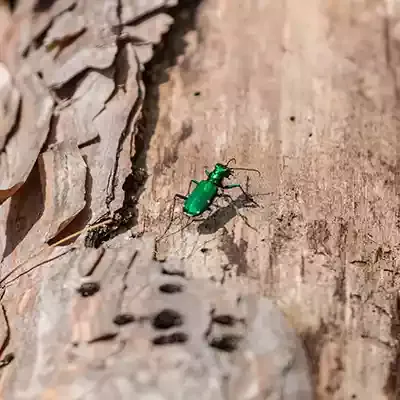Insects Plaguing Your Charleston Ornamentals

Pests can have a detrimental impact on the health and appearance of plants and trees. They feast on leaves, stems, and roots, causing significant damage to these vital parts of the plant's structure. This damage can weaken the plants, making them more susceptible to diseases and other stressors.
This results in stunted growth, yellowing leaves, and, eventually, defoliation. Furthermore, insects may transmit diseases while feeding on plants, further compromising their health. For instance, some insects act as carriers for plant viruses, which can cause severe damage and even death to the plants.
Consequently, the presence of pests not only impacts the health of plants and trees but also results in a diminished appearance. Plants will appear weak, withered, and lacking foliage. Trees may exhibit signs of decay, such as peeling bark or dead branches. The overall aesthetic value of the landscape is compromised, affecting the visual appeal for both residential and commercial areas.
Common Insects in Charleston
In Charleston, homeowners often find themselves facing a variety of pests that can wreak havoc on their yards. From insects that feed on grass roots to pests that chew on leaves and stems, these nuisances can quickly turn a beautifully manicured lawn into a patchy mess.
Asian longhorned beetle
The Asian longhorned beetle (Anoplophora glabripennis) is an invasive species that poses a significant threat to trees and forests in various regions. This distinct beetle is easily identifiable by its remarkable appearance. It measures approximately 1 to 1.5 inches in length and has a shiny black body with distinct white spots. One of its defining features is its long antennae, which can be up to twice the length of its body. These antennae, often referred to as "longhorns," give the beetle its name.
Originally native to Asia, this beetle has made its way to other parts of the world through international trade and transportation. It primarily inhabits deciduous trees such as maples, birches, and willows, but can infest a wide range of tree species. The beetle lays eggs on the bark of host trees, and once the larvae hatch, they burrow deep into the tree, disrupting its nutrient flow by feeding on the wood and creating extensive tunnels. This behavior weakens the tree, making it susceptible to disease and ultimately leading to its death.
The Asian longhorned beetle poses a significant threat to trees and forests due to its destructive feeding habits. When left unchecked, it can cause serious economic and ecological damage. The beetle has been identified in various regions, including North America (particularly in the northeastern United States and parts of Canada), Europe (such as Austria, Germany, and Italy), as well as Korea and Japan.
Crapemyrtle Bark Scale
Crapemyrtle Bark Scale (Acanthococcus ceriferus) is an invasive insect that poses a significant threat to Crapemyrtle trees and shrubs. This pest is small in size, typically measuring between 2-3 millimeters. It is characterized by a white waxy covering that protects its body from external elements. This covering gives affected plant surfaces a fuzzy or powdery appearance.
The infestation of Crapemyrtle Bark Scale can have various detrimental impacts on the plants. The scales feed on the sap of the trees, causing stunted growth and weakening the overall health of the plants. Moreover, as they feed, they excrete a sticky substance known as honeydew, which promotes the growth of black sooty mold. The black sooty mold not only affects the aesthetic appeal of the plants but also inhibits their ability to carry out photosynthesis, leading to reduced vigor and possible death.
Spider Mites
Spider mites are a specific type of arachnid that can cause significant harm to plants. These tiny pests, almost invisible to the naked eye, often infest both indoor and outdoor plants, causing damage to the leaves.

Spider mites are characterized by their minuscule size, making them hard to spot. They are usually found on the underside of leaves, where they suck out the plant's sap, leading to yellowing, browning, and eventually, leaf drop. The damage they cause can be devastating, especially if left untreated.
What makes spider mites particularly troublesome is their ability to reproduce rapidly. A female mite can lay hundreds of eggs during her 2-4 week lifespan. Under warm and dry conditions, their population can explode in a matter of days. This makes controlling them a challenging task.
Furthermore, spider mites thrive in warm and dry environments, which explains their preference for indoor and outdoor plants. They are especially common in greenhouses, where the warm temperatures and limited natural predators create the ideal environment for their rapid multiplication.
Lace Bugs
Lace Bugs, scientifically known as Tingidae, are a group of small insects that possess key characteristics which make them easily distinguishable. They have delicate, transparent wings, hence their name "Lace Bugs." Their bodies are generally flat and oval-shaped, measuring around 2 to 6 millimeters in length, with intricate patterns on their wings. Lace Bugs are commonly found in gardens, parks, and agricultural fields worldwide.
These bugs thrive in warm climates and prefer to inhabit the foliage of various plant species. They feed on the sap of plants by piercing the leaf tissue with their sharp mouthparts, gradually draining the plant's nutrients. Certain favored hosts include azaleas, roses, sycamores, and oak trees.
The damage caused by Lace Bugs can be easily overlooked, making early detection crucial. Their feeding habits result in yellow or whitish stippling on plant leaves, caused by the draining of chlorophyll. This leaves the leaves speckled and discolored, causing a weakened appearance. If left unchecked, infested plants may experience stunted growth, premature leaf drop, and reduced flowering or fruit production.
Early detection is of utmost importance as it allows for swift intervention to control Lace Bug populations. Integrated pest management practices, such as regular monitoring and appropriate insecticides, can help prevent widespread damage and preserve the health and vitality of affected plants.
Emerald Ash Borer
The Emerald Ash Borer (EAB) poses significant impacts on ash trees, both ecologically and economically. This destructive beetle devastates ash tree populations, leading to severe consequences.

Ecologically, the EAB decimates ash tree populations, resulting in a loss of these valuable trees from forests and urban areas. Ash trees are a critical component of ecosystems, providing habitat and food for numerous species. Their loss disrupts the balance of these ecosystems and affects biodiversity. Additionally, the reduced ash tree population leads to changes in forest structure and composition, potentially altering the overall functioning of ecosystems. This loss of ash trees also impacts carbon sequestration, as these trees are known to store carbon dioxide.
Economically, the impacts of the EAB are staggering. Ash trees have significant economic value, particularly within the timber and woodworking industries. The destruction caused by the EAB results in a decline in the availability of ash timber, leading to increased prices and reduced availability of ash wood products. Moreover, the cost of removing and replacing infected ash trees in urban and suburban areas is substantial. Municipalities spend significant resources on tree removal, and the loss of trees affects property values and aesthetics.
The life cycle of the EAB begins with adult beetles laying eggs on the bark of ash trees. Once hatched, the larvae tunnel into the tree and feed on the conductive tissues, disrupting the flow of water and nutrients. This feeding habit weakens the tree's ability to transport vital resources, leading to decline and eventually death. The larvae undergo several molts, causing extensive tunneling and damage within the tree. After a period of feeding, the mature larvae emerge from the tree, creating characteristic D-shaped exit holes in the bark. These adults then mate and begin the cycle anew on other healthy ash trees, perpetuating the devastation caused by the EAB.
Kudzu Bug
The Kudzu Bug (Megacopta cribraria) is an invasive species native to Asia that was first discovered in the United States in 2009. This bug has a relatively short life cycle, typically completing their life cycle in 5-6 weeks. The female Kudzu Bug lays eggs on the underside of kudzu leaves, where they hatch within a week.
In terms of appearance, adult Kudzu Bugs are small and oval-shaped, measuring about 1/4 inch long. They have mottled brown or olive-green coloration, with small spines on their backs. The nymphs, on the other hand, are smaller and brighter in color, ranging from red to orange.
Kudzu Bugs primarily feed on the sap of kudzu plants, which are a common vine in the southeastern United States. However, they also feed on other legumes, such as soybeans and other bean crops, causing significant damage. They use their piercing-sucking mouthparts to pierce plant tissues and extract sap.
The impact on crops can be severe, as the feeding damage weakens the affected plants, leading to stunted growth and reduced crop yields. Furthermore, the Kudzu Bug has shown resistance to several insecticides, making control methods challenging. Currently, integrated pest management techniques, such as cultural practices and biological control, are being explored as possible control measures.
The invasive nature of the Kudzu Bug poses several risks. Firstly, its rapid spread across different regions can lead to significant economic losses in the agricultural sector. Secondly, the bug's ability to adapt to various environmental conditions allows it to establish and thrive in new areas, displacing native species and disrupting ecosystems. Additionally, the Kudzu Bug has the potential to become a nuisance pest as it can invade homes and buildings seeking shelter during cooler seasons.
Japanese Beetle
The Japanese Beetle (Popillia japonica) is an invasive species of beetle that is native to Japan. It was first discovered in the United States in the early 1900s and has since spread across most of North America. This small beetle measures about half an inch in length and has a metallic green body with coppery brown wing covers. The mature adults have distinctly white tufts of hair along the sides of their abdomen.
The life cycle of the Japanese Beetle consists of four stages: egg, larva, pupa, and adult. The female beetles lay their eggs in the soil during early summer, which hatch into white grub-like larvae. These larvae feed on the roots of grass and other plants for about a year before transforming into pupae. In late spring or early summer, the adult beetles emerge from the soil and begin feeding on a wide variety of plants.
Japanese Beetles are known for their voracious feeding habits. They primarily feed on the leaves, flowers, and fruits of plants, causing severe defoliation. They are particularly attracted to roses, grapevines, linden trees, and other ornamental and edible plants, making them a significant threat to gardens, landscapes, and agricultural crops.
Brown Marmorated Stink Bug
The brown marmorated stink bug (Halyomorpha halys) is an invasive insect native to Asia. It is approximately 1.7 centimeters long and has a distinct shield-shaped body. Its coloration ranges from brown to gray, and its body is marked with alternating light and dark bands on its antennae and legs.
These stink bugs are known for their unpleasant odor, which they release as a defense mechanism when threatened or crushed. They feed on a wide range of plants, including fruits, vegetables, ornamental plants, and crops such as corn and soybeans.
Originally found in East Asia, the brown marmorated stink bug has spread to North America, Europe, and other parts of the world. It is highly adaptable and can thrive in various climates and environments.
The potential damage caused by brown marmorated stink bugs to crops and gardens is significant. They puncture the surface of fruits and vegetables with their piercing-sucking mouthparts, causing characteristic blemishes and discoloration. As a result, the affected produce becomes unmarketable. Additionally, they can reduce crop yields and affect plant health by introducing diseases.
Coastal Turf Can Help Protect Your Plants from Insects
Coastal Turf, our local Charleston lawn care company, can help protect your plants from insect infestations. By maintaining healthy and well-fertilized turf, Coastal Turf creates a barrier that deters insects from invading your ornamentals.